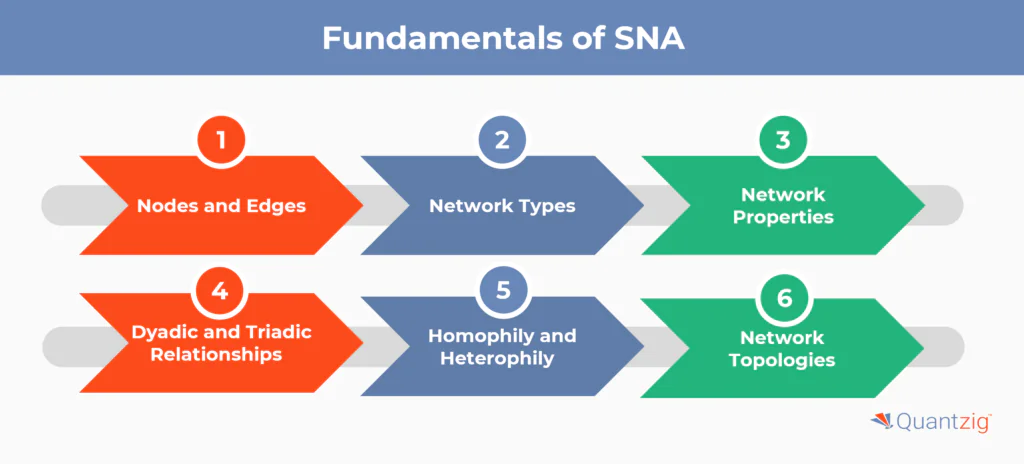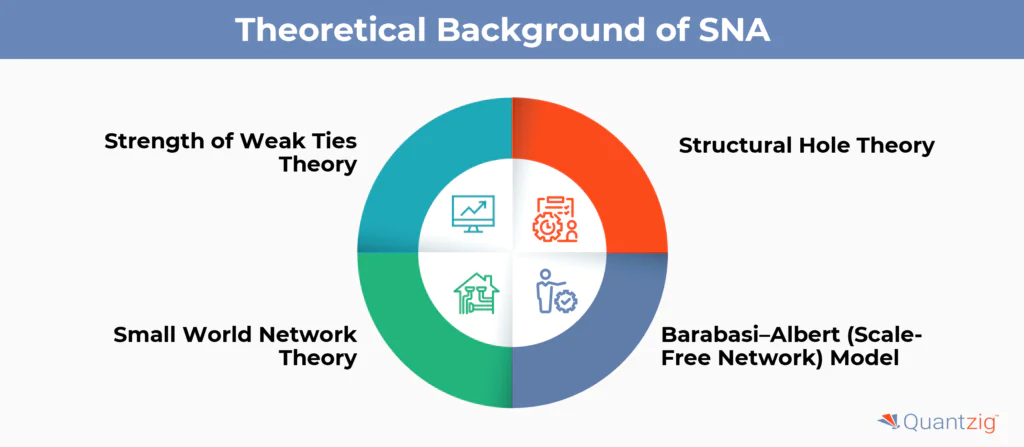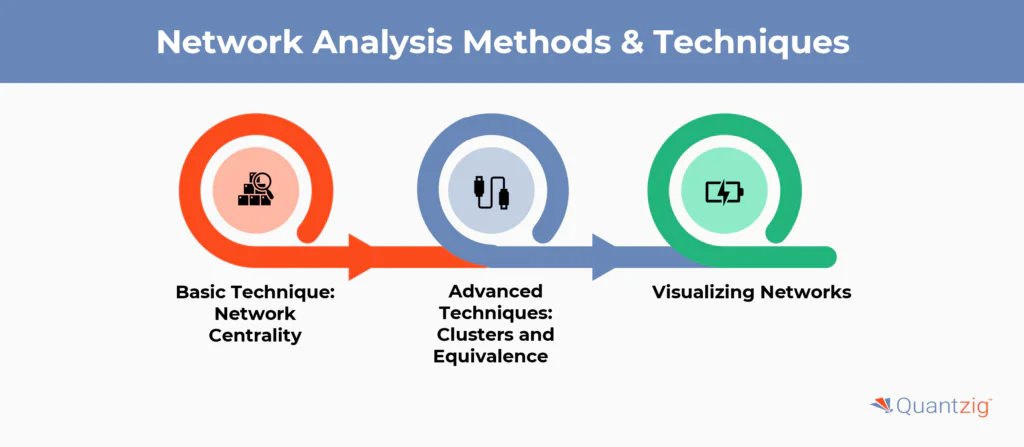Written By: Sudeshna Ghosh
Table of Contents
Key Takeaways for Social Network Analysis
- Social Network Analysis gives strategic insights into online networks, allowing businesses to pinpoint key influencers, target audience segments, and ideal communication channels to maximize their online presence and engagement.
- By leveraging SNA tools and techniques, data scientists can make data-driven decisions to optimize their online presence strategies. Examining network properties, like centrality measures and clustering coefficients, enables organizations to customize their online activities to effectively connect with and engage their target audience.
- SNA helps businesses grasp the dynamics of how information and influence spread within online networks. By identifying central nodes and clusters, organizations can strategically amplify their influence, increase brand visibility, and promote community engagement across various online platforms.
- Continuous monitoring and analysis of online networks through SNA let businesses adapt and refine their online presence strategies in response to changing trends, audience behaviors, and competitive landscapes. By staying agile and responsive, organizations can maintain a strong and impactful online presence over time.
Introduction
Social Network Analysis (SNA) is a research technique used to visualize and examine the relationships and links between people or groups within a network. For example, image mapping out the connections between different divisions in a company. The result would be a clear illustration of how each division communicates with the others, enabling us to identify communication habits, influential people or groups, and bottlenecks. In this extensive guide, we will present important principles, concepts, terminology, and methods for professionals centered on social change, systems transformation, and enhancement of community well-being. The guide aims to provide a thorough overview of key ideas and tools related to generating positive impact in communities and systems.
Book a demo to experience the meaningful insights we derive from data through our analytical tools and platform capabilities. Schedule a demo today!
Request a Free DemoThe Importance of Social Network Analysis (SNA)
SNA, a powerful tool, allows us to explore the underlying structure of an organization or any network, recognizing the informal and formal relationships that drive the formal processes and outcomes. This in-depth insight can enable better communication, facilitate change management, and inspire more efficient collaboration.
This methodology also helps demonstrate the impact of relationship-building and systems change efforts by documenting the changes in the quality and quantity of relationships before and after the initiative. The maps and visualizations produced by SNA are an engaging way to share your progress and impact with stakeholders, donors, and the community at large.
Also Read: Maximizing Marketing Budgets with Campaign ROI Analysis
Get started with your complimentary trial today and delve into our platform without any obligations. Explore our wide range of customized, consumption driven analytical solutions services built across the analytical maturity levels.
Start your Free Trial TodayFundamentals of SNA

Social network analysis (SNA) covers a wide range of concepts and ideas, but some key terms, concepts, and theories are fundamental to grasping how it functions. To comprehend the foundations of SNA, you need to be familiar with the core vocabulary, frameworks, and models that serve as the basis for this field. Though SNA contains many nuances, focusing on the fundamental building blocks of central concepts, foundational theories, and defining principles will provide the understanding required to apply this approach.
1. Nodes and Edges
In social network analysis (SNA), nodes stand for people or groups, and edges represent the connections between them. For instance, in a network of organizations, the nodes could be companies, and the edges might show communication, teamwork, or rivalry between them.
2. Network Types
Different kinds of networks are used for different functions. ‘Ego Networks’ concentrate on a single node and its direct links, uncovering its immediate connections. ‘Whole Networks’, conversely, portray a more expansive perspective, including an entire organization or framework. Open networks are freely associated, with numerous chances to construct new connections, perfect for advancement and conceptualizing – though closed networks are thickly interlinked, better for refining thoughts among a gathering who all know one another.
3. Network Properties
The characteristics of a network, such as density (the ratio of actual to possible connections), diameter (the greatest distance between two nodes), and centrality (the importance of a node in the network), enable us to comprehend the network’s architecture and purpose. Metrics can also evaluate the quality of relationships across the network, like our validated measures of trust and value.
4. Dyadic and Triadic Relationships
Preparing Data for Analysis Dyadic relationships have two participants, such as a partnership between two firms. Triadic relationships, with three participants, are more intricate but can provide more valuable understanding. For example, they might demonstrate how a third company affects the relationship between two others, or which people in your network excel at forming new connections between their peers.
5. Homophily and Heterophily
Homophily is the tendency for nodes that share similarities to form connections, whereas heterophily is the opposite – connecting nodes that are different. In business, we may observe homophily among companies in the same sector, and heterophily when looking to build a diverse supply chain. Many networks want diversity but end up repeatedly interacting with comparable, like-minded partners. These ideas about network configurations underpin approaches that encourage connecting with novel partners to stimulate innovation and avoid insular group thinking.
6. Network Topologies
In conclusion, the way a network is organized, and its topology, can tell us a lot about what purpose it serves. For example, a network with a centralized structure, where one node connects to all the others, could signal a hierarchy, while a decentralized structure with no clear central node implies a more cooperative, adaptable system. This aspect of how the network is laid out is also known as the network structure. Continue reading for more information.
Theoretical Background of SNA

There have been many theories proposed to explain how particular characteristics of networks, such as their structure, centrality, or category, lead to various results. Several important theories that are relevant to social network analysis are outlined below.
1. Strength of Weak Ties Theory
This theory suggests that weak social connections or acquaintances often provide more new information and resources than close relationships. These less important “weak” ties, which may appear unimportant, can act as crucial links between different groups within a social network.
2. Structural Hole Theory
This theory suggests that people who connect disconnected groups within a network, acting as a link between them, hold an advantageous position. By bridging the gaps, or structural holes, between groups, they can regulate and direct the flow of information and resources moving between the groups. This allows them to wield greater influence due to their strategic placement as middlemen between otherwise disconnected groups.
3. Small World Network Theory
This theory highlights how nodes within a network are linked together. It proposes that most nodes can be reached from any other by traveling through a small number of connections. This characteristic results in the well-known “six degrees of separation” phenomenon, showing that information can spread efficiently, and nodes are well-connected in a network.
4. Barabási–Albert (Scale-Free Network) Model
The model describes how networks change over time through preferential attachment. This means new nodes in the network tend to connect to nodes that already have many connections. As a result, the network develops a scale-free structure. In a scale-free network, a small number of nodes act as highly connected hubs, while most nodes have only a few connections. The model shows how this uneven, hub-like structure emerges naturally through the process of networks growing via preferential attachment.
Also Read: Track Business Progress with Marketing Analytics Dashboard
Experience the advantages firsthand by testing a customized complimentary pilot designed to address your specific requirements. Pilot studies are non-committal in nature.
Request a Free PilotNetwork Analysis Methods & Techniques

There are numerous techniques to study a network or group of entities using social network analysis (SNA). Here is an overview of some fundamental and sophisticated approaches, as well as information on network visualization – a key component and common result of SNA projects.
1. Basic Technique: Network Centrality
One popular method for examining a network is to consider the prominence of different nodes to pinpoint important actors, information centers, and gatekeepers within the network. There are three kinds of prominence, each related to a distinct facet of connectivity and central positioning. The metrics of Degree, Betweenness, and Closeness Prominence quantify a node’s significance.
- Degree Centrality
The network analysis technique can help pinpoint the actors that have the most connections to others in the network. These well-connected actors tend to be considered “popular” or “active” within the network. Their high number of direct ties typically gives them substantial influence over the network. In a coalition or network, the most connected nodes might be the organizations or people that participate the most or are the most engaged with the network’s activities. These central actors often serve as the main sources of information or resources for the network. As such, they can significantly shape the agenda and direction of the overall group.
- Betweenness Centrality
A useful technique for identifying the “brokers” or “gatekeepers” in a network is to look for actors who have a unique position connecting different parts of the network. These brokers facilitate or control the flow of information, resources, and support between other actors by their position between key players. In a coalition or collaborative context, the brokers could be organizations or individuals who influence the network by bridging disconnected groups. They play crucial roles in enabling collaboration, negotiation, and conflict resolution across the network. Their positional advantage allows them to mediate interactions and exchanges within the broader network. Identifying and understanding these broker actors is important for mapping and analyzing network dynamics.
- Closeness Centrality
A measure of how fast a member in the network can connect with all other members through the shortest routes. In an alliance, these members can spread information or have an impact rapidly because of their closeness to all other members. These ‘effective connectors’ are good for the quick distribution of information, resources, or new things across the network. They could play a very important role during times of fast change or when quick collective action is needed.
2. Advanced Techniques: Clusters and Equivalence
- Clustering Coefficients
The Clustering Coefficient offers insights into the interconnectedness of local cohesion of the network surrounding particular nodes. In a coalition or inter-organizational network, a high clustering coefficient may signify that a node’s links are also straight connected, forming tightly bound groups or sub-communities within the greater network. These groups frequently share common interests or goals, and they may collaborate or share resources more actively. Grasping these clusters can be vital for coalition administration as it can highlight probable subgroups that may need to be engaged differently, or that might hold diverse levels of influence or dedication to the coalition’s overarching objectives.
- Structural Equivalence
Structural Equivalence looks at nodes that have comparable connection patterns, despite not having a direct link between them. In a coalition setting, structurally equivalent groups or people often fill comparable roles or positions in the network. As a result, they may share similar interests, sway, or duties. They could be competing or cooperating groups in the same fields or work areas. Grasping structural equivalence can provide insights into the network’s dynamics, like possible redundancies, rivalry, or chances to work together. It can also show how shifts in one network part may affect other, structurally equivalent network parts.
3. Visualizing Networks
Network visualization is an important technique in Social Network Analysis (SNA) that enables researchers and interested parties to grasp the overall ‘big picture’ of the network’s structure and identify patterns and details that might not be clear just by looking at numerical data. Some key features and advantages of using network visualization for a coalition or network of multiple organizations include:
- Summary of Network Structure: Visualizations provide an overview of the full network, displaying both nodes (people or groups) and edges (relationships or interactions). This helps comprehend the total size, density, and complexity of the network. Seeing these connections mapped out can often make the network’s structure more concrete and easier to grasp.
- Pinpointing Key Players: Centrality measures can be shown visually, making it simpler to identify key people or groups within the network. Nodes with high degrees, gatekeepers, and efficient connectors will stand out visually, which can help determine who wields influence or authority in the network.
- Recognizing Subgroups and Communities: Visualization can also highlight clusters or subgroups within the network. These may be founded on shared interests, common goals, or frequent interaction. Understanding these subgroups is vital for coalition management and strategic planning, since different groups may have unique needs, concerns, or levels of engagement.
- Pinpointing Outliers and Minimal Participants: Visual representations of networks can also assist in singling out outliers or peripheral members – those less involved or linked within the network. These individuals may symbolize chances for more engagement or possible dangers to network unity.
- Exposing Network Fluctuations: Visuals can demonstrate transformations in the network over time, like the development or disintegration of connections, the addition or departure of members, or shifts in members’ prominence. These variations can give useful understandings of how the coalition or network has evolved and the effects of different initiatives or happenings.
Introduction to Popular SNA Tools

Various software tools exist to conduct social network analysis and visualize networks. Popular options include UCINet, Gephi, and Pajek. They offer an assortment of functions to analyze and visualize networks, meeting the needs of users with different skill sets. The following introduces ten tools suitable for diverse contexts and uses.
UCINet is a comprehensive software to analyze social networks as well as other single-mode and two-mode data. NetDraw is commonly used with UCINet to visualize networks. Gephi is open-source network analysis and visualization software written in Java. NodeXL offers free and open-source network and social analysis and visualization capabilities as an add-in for Excel. Kumu is a powerful platform for mapping systems and elucidating relationships. Pajek excels at handling large network datasets to analyze and visualize substantial networks. SocNetV is user-friendly, free, open-source software for visualization. Cytoscape is bioinformatics software to visualize molecular interaction networks. Graph-tool is an efficient Python module to manipulate and statistically analyze graphs. Polinode provides tools for network analysis, to analyze your data and gather new network data.
Choosing the Right Tool for Your Analysis
The correct tool to choose depends on your requirements. For people just starting, an easy-to-use interface could be a top priority, while seasoned experts might want more sophisticated capabilities. You should also think about the extent and intricacy of your system, plus your financial plan. Those factors are key things to think about too.
Challenges and Future Directions in Social Network Analysis
Within the social network analysis (SNA), there are both ongoing difficulties and promising opportunities ahead. Although tools like Graph Theory, Python, and NetworkX facilitate social media analysis, data scientists still struggle to fully grasp the intricacies of real-world networks and collaborative environments. Even with advancements in Network Theory and platforms like GitHub, challenges remain in effectively promoting community health improvement through systems change efforts and assessing social impact. As network science progresses, organizations such as Visible Network Labs play a crucial role in navigating these challenges by emphasizing key tenets and further developing foundational SNA theories. Future directions in SNA involve refining data collection techniques and enhancing network analysis methods to uncover deeper insights into social dynamics, with the ultimate goals of driving positive societal change and cultivating healthier, more resilient communities.
What are the Current Trends and Future Predictions of Social Network Analysis?
In the field of social network analysis (SNA), current developments and future projections show a growing dependence on methodologies based on Graph Theory, supported by Python libraries like NetworkX and collaborative platforms like GitHub, to unravel the complex structures of real-world networks. Data scientists, with a solid grasp of Network Theory and guided by key principles, are increasingly leveraging SNA to address pressing network optimization and social issues, such as social impact and community health improvement, through collaborative ecosystems and systems change initiatives. As organizations like Visible Network Labs champion the advancement of network science, the future of SNA lies in harnessing the power of data collection and refining network analysis methods to gain deeper insights into social dynamics. These trends point towards more advanced and impactful applications of SNA in the future, driving positive change and building resilient communities in the coming years.
How can Quantzig help a Business with Social Network Analysis?
Quantzig provides analytics services to help companies leverage social network analysis (SNA) and gain valuable insights to inform strategic decisions. Through advanced analytics and expertise in network science, we support clients in several key areas:
- Identifying Influencers: Our team assists companies with pinpointing influential people within their social networks. This allows for targeted marketing efforts and strategic partnerships to increase brand visibility and reach.
- Detecting Communities: By examining social network data, we find communities and clusters within networks. This enables businesses to understand group dynamics, focus on specific audience segments, and adapt communication approaches accordingly.
- Analyzing Information Flow: Our studies how information spreads and influences behaviors within social networks. This provides insights into how to optimize content distribution strategies and boost engagement with target audiences.
- Optimizing Initiatives: Using SNA, Quantzig helps businesses enhance the impact and efficiency of initiatives aimed at driving social change and community health improvements. Understanding network structures and dynamics allows organizations to design more effective programs and allocate resources strategically.
- Informing Decisions: We deliver actionable insights from SNA to support strategic decision-making. Whether identifying partnership opportunities, optimizing supply chains, or improving customer relationships, our SNA expertise empowers data-driven decisions that spur growth and success.
Overall, our customized solutions and SNA expertise help businesses fully leverage their social networks, enabling tangible outcomes and long-term success.
Conclusion
In summary, social network analysis (SNA) is an essential tool for comprehending the intricate structures and dynamics within social systems. By examining clusters, real data sets, and social structures, SNA uncovers valuable insights into how information spreads, impacting everything from marketing tactics to fraud detection. Using components like directed graphs and centrality measures, SNA investigates dyadic and triadic relationships, revealing phenomena such as small-world networks and scale-free networks.
Through tools like Pandas data frames and techniques like the linear threshold model, SNA enables the exploration of diverse network types and properties. As the field evolves, future directions in SNA promise advancements in network visualization and applying theories such as the strength of weak ties theory. Despite limitations, current trends indicate the continued importance of SNA, with future predictions pointing to its pivotal role in understanding and navigating the complex interconnected social systems in the digital era.



